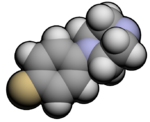
Summary
para-Fluorophenylpiperazine (pFPP, 4-FPP, 4-Fluorophenylpiperazine; Fluoperazine, Flipiperazine) is a piperazine derivative with mildly psychedelic and euphoriant effects.[2][3] It has been sold as an ingredient in legal recreational drugs known as "Party pills", initially in New Zealand and subsequently in other countries around the world.[4]
 | |
 | |
| Clinical data | |
|---|---|
| Routes of administration | Oral |
| Legal status | |
| Legal status | |
| Pharmacokinetic data | |
| Metabolism | Hepatic |
| Elimination half-life | 6–8 hours |
| Excretion | Renal |
| Identifiers | |
| |
| CAS Number |
|
| PubChem CID |
|
| UNII |
|
| CompTox Dashboard (EPA) |
|
| ECHA InfoCard | 100.017.134 |
| Chemical and physical data | |
| Formula | C10H13FN2 |
| Molar mass | 180.226 g·mol−1 |
| (verify) | |
pFPP has been found in vitro to act mainly as a 5-HT1A receptor agonist, with some additional affinity for the 5-HT2A and 5-HT2C receptors. It has also been shown to inhibit the reuptake of serotonin and norepinephrine, and to possibly induce their release.
pFPP was originally discovered as a metabolite of the hypnotic 5-HT2A and α1-adrenergic receptor antagonist niaprazine in 1982,[5] but was rediscovered in 2003 as a potential recreational drug, and sold as an ingredient in "Party pills" in New Zealand, under brand names such as "The Big Grin", "Mashed", and "Extreme Beans". Subsequently it has continued to be used as an ingredient in black market "ecstasy" pills around the world.[6]
pFPP has little stimulant effects, with its subjective effects derived mainly from its action as a 5-HT1A receptor agonist.[7] pFPP is active at doses between 20 and 150 mg, but higher doses cause a range of side-effects such as migraine headaches, muscle aches, anxiety, nausea, and vomiting. Metabolic studies have shown pFPP to be an inhibitor of various Cytochrome P450 enzymes in the liver which may contribute to its side-effect profile.[8]
Based on the recommendation of the EACD, the New Zealand government has passed legislation which placed BZP, along with a number of other piperazine derivatives, into Class C of the New Zealand Misuse of Drugs Act 1975. A ban was intended to come into effect in New Zealand on December 18, 2007, but the law change did not go through until the following year, and the sale of BZP and the other listed piperazines became illegal in New Zealand as of 1 April 2008. An amnesty for possession and usage of these drugs remained until October 2008, at which point they became completely illegal.[9] This drug has been detected in a drug-facilitated sexual assault case in the United States of America.[citation needed]
See also edit
References edit
- ^ "Ustawa z dnia 15 kwietnia 2011 r. o zmianie ustawy o przeciwdziałaniu narkomanii ( Dz.U. 2011 nr 105 poz. 614 )". Internetowy System Aktów Prawnych. Retrieved 17 June 2011.
- ^ Erowid Experience Vaults: Piperazines - pFPP - Refreshing Enhancement - 62575
- ^ Erowid Experience Vaults: Piperazines - pFPP - A Little Flip'd Out - 56641
- ^ King LA. Forensic Chemistry of Substance Misuse. A Guide to Drug Control. Royal Society of Chemistry. (2009) pp 100–102. ISBN 978-0-85404-178-7
- ^ Keane PE, Strolin Benedetti M, Dow J. The effect of niaprazine on the turnover of 5-hydroxytryptamine in the rat brain. Neuropharmacology. 1982 Feb;21(2):163-9.
- ^ DEA Microgram Bulletin August 2009[permanent dead link]
- ^ Scherman D, Hamon M, Gozlan H, Henry JP, Lesage A, Masson M, Rumigny JF. Molecular pharmacology of niaprazine. Progress in Neuro-psychopharmacology and Biological Psychiatry. 1988;12(6):989-1001.
- ^ Antia U, Tingle MD, Russell BR (July 2009). "Metabolic interactions with piperazine-based 'party pill' drugs". The Journal of Pharmacy and Pharmacology. 61 (7): 877–82. doi:10.1211/jpp.61.07.0006. PMID 19589229.
- ^ Misuse of Drugs (Classification of BZP) Amendment Bill 2008


